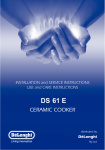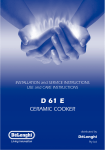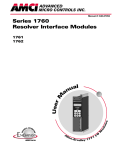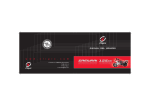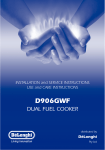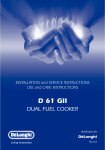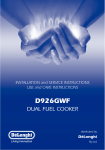Download DeLonghi DE 60 E Specifications
Transcript
INSTALLATION and SERVICE INSTRUCTIONS USE and CARE INSTRUCTIONS DE 60 E CERAMIC COOKER distributed by DèLonghi Pty Ltd Dear Customer, Thank you for having purchased and given your preference to our product. The safety precautions and recommendations reported below are for your own safety and that of others. They will also provide a means by which to make full use of the features offered by your appliance. Please keep this booklet in a safe place. It may be useful in future, either to yourself or to others in the event that doubts should arise relating to its operation. This appliance must be used only for the task it has explicitly been designed for, that is for cooking foodstuffs. Any other form of usage is to be considered as inappropriate and therefore dangerous. The manufacturer declines all responsibility in the event of damage caused by improper, incorrect or illogical use of the appliance or be faulty installation. Important: This appliance is designed and manufactured solely for the cooking of domestic (household) food and is not suitable for any non domestic application and therefore should not be used in a commercial environment. The appliance guarantee will be void if the appliance is used within a non domestic environment i.e. a semi commercial, commercial or communal environment. PRODUCT LABEL 2 USING THE OVEN FOR THE FIRST TIME You are advised to carry out the following operations: ■ Furnish the interior of the oven. ■ Switch the empty oven ON at maximum temperature for about two hours to eliminate traces of grease and smell from the components. Disconnect the appliance from the electric power supply and clean the interior of the oven with a cloth soaked in water and neutral detergent and dry thoroughly. ■ IMPORTANT PRECAUTIONS AND RECOMMENDATIONS FOR USE OF ELECTRICAL APPLIANCES Use of any electrical appliance implies the necessity to follow a series of fundamental rules. In particular: ■ Never touch the appliance with wet hands or feet; ■ Do not operate the appliance barefooted; ■ The appliance is not intended for use by young children or infirm persons without supervision; ■ Young children should be supervised to ensure they do not play with the appliance. The manufacturer cannot be held responsible for any damages caused by improper, incorrect or illogical use of the appliance. This cooker has been designed and constructed in accordance with the following codes and specifications: AS/NZS 60335-1 General Requirements for Domestic electrical appliances AS/NZS 60335-2-6 Particular Requirements for Domestic electrical cooking appliances AS/NSZ 1044 Electromagnetic Compatibility Requirements. 3 IMPORTANT PRECAUTIONS AND RECOMMENDATIONS After having unpacked the appliance, check to ensure that it is not damaged. In case of doubt, do not use it and consult your supplier or a professionally qualified technician. Packing elements (i.e. plastic bags, polystyrene foam, nails, packing straps, etc.) should not be left around within easy reach of children, as these may cause serious injuries. ■ Do not attempt to modify the technical characteristics of the appliance as this may become dangerous to use. ■ Do not carry out cleaning or maintenance operations on the appliance without having previously disconnected it from the electric power supply. ■ After use, ensure that the knobs are in the off position. ■ The appliance is not intended for use by young children or infirm persons unless they have been adequately supervised by a responsible person to ensure that they can use the appliance safely. ■ During and after use of the appliance, certain parts will become very hot. Do not touch hot parts. Care should be taken to avoid touching heating elements inside the oven. ■ Keep children away from the appliance when it is in use. ■ Young children should be supervised to ensure that they do not play with the appliance. ■ Some appliances are supplied with a protective film on steel and aluminium parts. This film must be removed before using the appliance. ■ Make sure that electrical cables connecting other appliances in the proximity of the cooker cannot come into contact with the hob or become entrapped in the oven door. ■ Do not line the oven walls with aluminium foil. Do not place baking trays or the drip tray on the base of the oven chamber. ■ WARNING When correctly installed, your product meets all safety requirements laid down for this type of product category. However special care should be taken around the rear or the underneath of the appliance as these areas are not designed or intended to be touched and may contain sharp or rough edges, that may cause injury. ■ Fire risk! Do not store flammable material in the oven and in the drawer. ■ Always use oven gloves when removing the shelves and food trays from the oven whilst hot. Do not hang towels, dishcloths or other items on the appliance or its handle – as this could be a fire hazard. Do not allow heavy or sharp objects to drop on the glass ceramic hob. If the hob is cracked or otherwise damaged by falling objects etc., disconnect the electrical power cord and call Customer Service. Do not scratch the hob with sharp objects. Don't use the hob as a work surface. Clean the oven regularly and do not allow fat or oils to build up in the oven base or tray. Remove spillages as soon as they occur. Do not stand on the open oven door. Always stand back from the appliance when opening the oven door to allow steam and hot air to escape before removing the food. This appliance is for domestic use only. Safe food handling: leave food in the oven for as short a time as possible before and after cooking. This is to avoid contamination by organisms which may cause food poisoning. Take particular care during warmer weather. The manufacturer declines all liability for injury to persons or damage to property caused by incorrect or improper use of the appliance. ■ ■ ■ ■ ■ ■ ■ ■ ■ ■ ■ 4 WARNING: Taking care NOT to lift the oven by the door handle. IMPORTANT NOTE: This appliance shall not be used as a space heater, especially if installed in marine craft or caravans. INSTALLATION CAUTION: ■ ■ ■ ■ ■ This appliance must be installed in accordance with these installation instructions. This appliance shall only be serviced by authorized personnel. This appliance is to be installed only by an authorised person. Incorrect installation, for which the manufacturer accepts no responsibility, may cause personal injury of damage. Always disconnect the cooker from mains power supply before carrying out any maintenance operations or repairs. ELECTRICAL REQUIREMENTS ■ The appliance must be connected to the mains checking that the voltage corresponds to the value given in the rating plate and that the electrical cable sections can withstand the load specified on the plate. ■ The appliance must be connected directly to the mains placing an two pole switch with minimum opening between the contacts of 3 mm between the appliance and the mains. ■ The power supply cable must not touch the hot parts and must be positioned so that it does not exceed 75°C at any point. ■ Once the appliance has been installed, the switch must always be accessible. ■ If the supply cord is damaged it must be replaced by the manufacturer or it’s Service Agent or a similarly qualified person in order to avoid a hazard. N.B. The connection of the appliance to earth is mandatory. If the installation requires alterations to the domestic electrical system call a qualified electrician. He should also check that the electrical system is suitable for the power drawn by the appliance. Replacing the power cord must be done by a qualified electrician in accordance with the instructions supplied by the manufacturer and in compliance with established electrical regulations. 5 CONNECTING THE FEEDER CABLE Important! This cooker must be connected to the electricity supply only by an authorised person. To connect the feeder cable to the cooker it is necessary to: ■ Remove the screws that hold shield A behind the cooker (fig. 2). ■ Fitted with a 5-pole terminal block, position the U bolts “C” onto terminal block “B” according to the diagram in fig. 1. ■ Feed the supply cable through the cable clamp “D”. The supply cable must be of a suitable size for the current requirements of the appliance; see the section “Feeder cable section”. ■ Connect the phase wires to the terminal block “B” and the earth wire to the terminal “PE” as shown in figure 2. ■ Take up any slack in the cable and secure with the cable clamp “D”. ■ Replace the cover “A”. N.B. The earth conductor must be left about 3 cm longer than the others. Voltage and power consumption 230 V~ 50 Hz 8700 W (37.8 A) (diversity not applied) 240 V~ 50 Hz 9500 W (39.5 A) (diversity not applied) Feeder cable section 230-240 V~ 3 x 4 mm2 (*) 1 2 3 4 5 This cooker must be connected to electrical supply using V105 insulated cable. B (*) Connection with wall box connection. - Diversity factor applied - A diversity factor may be applied to the total loading of the cooker only by a suitably qualified person. C Figure 2 D B Figure 1 PE 230-240 V~ 1 2 3 4 5 L1 6 N (L2) PE A IMPORTANT – The appliance should be installed by a registered electrician in compliance with the current electrical regulations and in observation of the instructions supplied by the manufacturer. Failure to comply with this condition will render the guarantee invalid. – Always disconnect the cooker from mains power supply before carrying out any maintenance operations or repairs. LOCATION The cooker can be installed in a cabinet. The cooker must be installed no less than 50 mm away from any side wall which exceed the height of the cooktop; The appliance must be housed in heat resistant units. The walls of the units must be capable of resisting temperatures of 75 °C above room temperature. Do not install the appliance near inflammable materials (eg. curtains). 500 mm 450 mm 650 mm Figure 3 50 mm minimum 7 LEVELLING THE COOKER The cooker is equipped with 4 levelling feet and may be levelled by screwing or unscrewing the feet with a spanner (fig. 6). It is important to observe the prescriptions of figures 4a, 4b. Figure 4a 0 +8 Figure 5 mm Figure 4b Supplied with the cooker in a separate kit Figure 6 + 8 mm + 15 mm A U T O 8 ANTI-TILT BRACKET Dotted line showing the position of the cooker when installed Important! To restrain the appliance and prevent it tipping accidentally, fit a bracket to its rear to fix it securely to the wall. Make sure you also fit the supplied lock pin to the anti-tilt bracket. = = To fit the anti-tilt bracket: 75 1. After you have located where the cooker is to be positioned, mark on 0 the wall the place where the two +15 screws of the anti-tilt bracket have to be fitted. Please follow the indicamin 95 - max 110 tions given in Fig.7a. (depending on feet height adjustment) 2. Drill two 8 mm diameter holes in the wall and insert the plastic plugs supFigure 7a Fitting the anti-tilt bracket plied. Important! Before drilling the holes, check that you will 1 not damage any pipes or electrical wires. 3. Loosely attach the anti-tilt bracket with the two screws supplied. 4. Move the cooker to the wall and adjust the 2 height of the anti-tilt bracket so that it can engage in the slot on the cooker’s back, as shown in Fig. 7a. 5. Tighten the screws attaching the anti-tilt bracket. 6. Push the cooker against the wall so that the anti3 tilt bracket is fully inserted in the slot on the cooker’s back. 7. Access the bracket and fit the lock pin: • Remove the drawer (Fig. 7b). 4 • Fit the lock pin through the bracket, as shown (Fig. 7c). • Refit the drawer. Figure 7b Removing the drawer Anti-tilt bracket attached on the rear wall 1 Cooker’s back Lock pin Slot on the cooker’s back 2 Lock pin correctly fitted Figure 7c Fitting the lock pin through the bracket 9 USE and CARE CAUTION: ■ This appliance must be used only for the task it has explicitly been designed for, that is for domestic cooking of foodstuffs. Any other form of usage is to be considered as inappropriate and therefore dangerous. ■ Do NOT place combustible materials or products on this appliance at any time. USING THE OVEN FOR THE FIRST TIME Operate as follows: ■ Assemble the wire racks on the oven walls using the 2 screws (fig. 8) interposing the catalytic panels A with the arrow up (fig. 8). ■ Slide in the grease filter on the back of the oven as in Fig. 11. ■ Slide in, on the guides, the shelf and the tray (fig. 9). The rack must be fitted so that the safety catch, which stops it sliding out, faces the inside of the oven. Figure 8 A 10 A ■ To eliminate traces of grease in manufacture it is necessary to preheat the oven at the maximum temperature: • For 60 minutes in the position, for 30 minutes in the position and for another 15 minutes in the position. ■ Unscrew the fixing screws and slide off the wire racks and the catalytic liners to the oven wall as in fig. 8. The grill is secured to the rear wall of the oven on a hinge system that allows it to be lowered to allow proper access when cleaning the oven ceiling (fig. 10). ■ Clean the inside of the oven with a cloth soaked in water and neutral detergent and dry thoroughly. GREASE FILTER ■ ■ ■ Figure 9 Figure 10 Figure 11 A special screen is provided at the back of the oven to catch grease particles, mainly when meat is being roasted fig. 11). Clean the filter after any cooking! The grease filter can be removed for cleaning and should be washed regularly in hot soapy water (fig. 11). Always dry the filter properly before fitting it back into the oven. CAUTION: When baking pastry etc. this filter should be removed. 11 TELESCOPIC SLIDING SHELF SUPPORTS The telescopic sliding shelf supports make it safer and easier to insert and remove the oven shelves and trays. They stop when they are pulled out to the maximum position. Important! When fitting the sliding shelf supports, make sure that you fit: ■ The slides to the top wire of a rack. They do not fit on the lower wire. ■ The slides so that they run out towards the oven door. ■ Both sides of each pair of shelf slides. ■ Both sides on the same level. ■ Note: you cannot fit the sliding shelf supports to the top shelf position (fig. 12). To fix the sliding shelf support onto the side racks: ■ Screw the side rack onto the oven wall interposing the catalytic panels (Fig. 8). ■ Fit the sliding shelf support onto the top wire of a rack and press (Fig. 12). You will hear a click as the safety locks clip over the wire. Figure 12 Left Right 12 To remove the telescopic sliding shelf supports: – Remove the side racks and the catalytic liners by unscrewing the fixing screws (Fig. 13). – Lay down the telescopic sliding shelf support and side racks, with the telescopic sliding shelf support underneath. – Find the safety locks. These are the tabs that clip over the wire of the side rack (arrow 1 in Fig. 14). – Pull the safety locks away from the wire to release the wire (arrow 2 in Fig. 14). Cleaning the sliding shelf supports – Wipe the supports with a damp cloth and a mild detergent only. – Do not wash them in the dishwasher, immerse them in soapy water, or use oven cleaner on them. Figure 14 Figure 13 1 2 1 13 CONTROL PANEL Figure 15 10 9 8 P A U T O 7 6 5 4 3 2 1 CONTROL PANEL - Controls description 1. 2. 3. 4. 5. 6. 7. Front right cooking zone control knob Rear right cooking zone control knob Rear left cooking zone control knob Front left cooking zone control knob Multifunction oven switch knob Multifunction oven thermostat knob Electronic programmer Pilot lamps: 8. Cooktop element hot surface indicator light 9. Cooktop element ON indicator light 10. Oven thermostat indicator light Please note: This appliance incorporates a safety cooling fan which you will hear operating whenever the oven or grill are in use. This fan is to reduce the external temperature of the appliance and cool the internal components. 14 VITROCERAMIC HOB Figure 16 1 4 2 3 COOKING ZONES 1. 2. 3. 4. Radiant Radiant Radiant Double hotplate hotplate hotplate circuit radiant hotplate Ø Ø Ø Ø 145 180 145 210/120 1200 W 1800 W 1200 W 2100/700 W Attention: Detach the appliance from the mains if the ceramic hob is cracked and contact the After Sales Service. The ceramic surface of the hob allows a fast transmission of heat in the vertical direction, from the heating elements underneath the ceramic glass to the pans set on it. The heat does not spread in a horizontal direction, so that the glass stays “cool” at only a few centimeters from the cooking plate. The 4 cooking zones are shown by painted disks on the ceramic surface. Before switching on the cooktop make sure that it is clean. 15 HOW TO USE THE VITROCERAMIC HOB IMPORTANT NOTE: The heating elements incorporate a thermolimiter that switches the element ON/OFF during all settings to protect the ceramic glass from overheating. The use of incorrect pans and/or wrong pan positioning will cause the temperature limiter to operate more frequently, resulting in a reduction of cooking performance. RADIANT HOTPLATES ■ The heating element is formed of a coil of resistant material which reaches the working temperature quickly. ■ It is controlled by a continuous energy regulator switch from 1 (minimum position) to 12 (maximum temperature) (fig. 17). ■ Turn the control knob clockwise. The light on the control panel will be lit when the hotplate is in use. Figure 17 16 (fig. 18) Figure 18 DOUBLE RADIANT ZONE (fig. 20) The heating element is formed of a coil of resistant material which reaches the working temperature quickly. Operation of the cooking zone is controlled by a continuous energy regulator from 1 to 12 (maximum temperature) (fig. 19). To turn on both zones of the double element, turn the double element knob fully clockwise to the position . To reduce the heat of the full double element, turn its knob anticlockwise to setting 12 or lower. Adjust the heat during cooking as necessary. Note: if you leave the knob at the position, the full double element will remain at the highest heat setting. To return to using only the inner zone of the double element, first turn the knob to the 0 (off) position (you should feel a click) and then clockwise to a setting from 1 to 12. Figure 19 Figure 20 Second element 17 SAFETY HINTS: 1. Never put cooking foil or plastic materials on the ceramic surface when the hob is hot. 2. Make sure that the hob is clean before you use it. 3. Remember that the plates will remain hot for approximately half an hour after the plate has been switched off. 4. Before you switch the hob on, make sure that you know which knob controls the required hot plate. We advise you to set the pan over the cooking plate before switching it on. 5. Pan handles should never stand beyond the kitchen work top. This will ensure that children cannot reach them. 6. Do not use pans with rough bases as these may scratch the hob surface. 7. DO NOT use the hob if the glass surface is broken or cracked in any way. Please disconnect the appliance from the mains and call the After-Sales Service. 8. Do not lean over the cooking plate when in use. 9. Follow the cleaning instructions carefully. 10. Always ensure that the base of your saucepan is clean and dry before placing on the hob. 11. Never use the glass surface for storage. WARNING: ■ HOBS BECOME VERY HOT WITH USE, AND RETAIN THEIR HEAT FOR A LONG TIME AFTER COOKING HAS FINISHED. CHILDREN SHOULD BE SUPERVISED AT ALL TIMES AND BE PREVENTED FROM TOUCHING THE HOT SURFACES UNTIL SUCH TIME AS THE APPLIANCE HAS COOLED. Figure 21 Figure 22 DO NOT USE GLASSWARE ON CERAMIC HOBS. DO NOT USE PANS WITH ROUGH CIRCULAR MACHINED BASE. 18 Figure 23 RESIDUAL HEAT INDICATOR The hob also features a warning lamp (on the control panel fig. 23) which is wired to the plates. When the temperature of a cooking plate is over 60°C, the warning lamp is also lit-up to warn of heat on the surface of the hob. This lamp also stays on after the cooking plate has been switched off to shown that the hob surface is still hot. This residual heat lasts for a rather long time after the cooking plate has been switched off. During this spell of time you should avoid touching the hob surface over the cooking plate; please pay special attention to children. The lamp will switch off automatically as soon as the surface temperature of the cooking plate falls below 60°C. Caution! the cooking hob becomes very hot during operation. Keep children well out of reach. Cooking hints: – To reduce the cooking time, you can turn the control knob to the max when you switch the plate on. After a short time you will set the control knob to the required position for the cooking. – You should use pots and pans with flat bases (pans with the test mark for glassceramic hobs are available from specialist shops). The diameter of the pan should match that of the cooking plate (or be slightly bigger) to make the most of the energy. – Since the cooking surface stays hot for a certain time after the plate has been switched off, you can switch it off 5 or 10 minutes before the end of the cooking. The residual heat of the hob will complete the cooking. – To save electricity, use pan lids whenever possible. – Never cook the food directly on the glass ceramic cooktop, but in special pans or containers. – Do not scratch the cooktop with cutting or sharp objects. Do not use the glass ceramic surface as a work surface 19 Figure 24 Elements usage table COOKING HINTS: Knob setting Type of cooking Temperature control knob 2 3 Warming 1 5 6 7 Cooking 4 8 10 11 12 ■ Roasting - Frying 9 0 Switched OFF 1 2 For melting operations (of butter or chocolate). 2 3 4 To keep foods warm or heat small quantities of water. 4 5 6 To heat greater quantities of water, and to reheat and simmer soups and stews. 6 7 Slow boiling, e.g. spaghetti, soups, stews. 7 8 For all kinds of fried foods, steaks, cutlets and cooking without a lid. 8 9 10 For browning of meat, cooked potatoes, fried fish and for boiling large quantities of water. 11 12 Rapid frying, grilled steaks, etc. Switching on the second element (Double zone only). Please note that these are only guidelines, you will quickly learn from experience which setting is correct for your needs. ECONOMIC COOKING ■ The ceramic glass retains heat, so you may find that you can switch off the heat 5 minutes before you finish cooking. ■ 20 To reduce the cooking time, the plate can be set to the maximum setting at the beginning. It can then be reduced later. COOKWARE: It is very important that the pans used on the hobs are made of a suitable material and have the correct base as follows: ■ The base should be flat and smooth. ■ Any rough part on the pan base could scratch the hob surface. ■ Choose pans which are the same size as the hotplates and with bases that are as non reflective as possible. eg. dull and dark. Only pans recommended for use on ceramic hobs should be used. Pans made of the following materials can cause problems: Cast Iron ■ The base may be rough which will scratch the hob. Toughened Glass ■ If the pans become too hot, the hob may overheat causing the safety cut out to operate too frequently thus reducing the cooking efficiency. Copper ■ Can easily distort and will therefore not form a good contact between base and hob which will result in uneven cooking. 21 MULTIFUNCTION OVEN GENERAL FEATURES With the Multi-Function oven it is possible to cook a variety of food using the 6 different cooking functions. These 6 cooking functions are obtained using a combination of the 4 different heating elements plus a defrost function using the fan only. OPERATING PRINCIPLES Heating and cooking in the MULTI-FUNCTION oven are obtained in the following ways: a. by normal convection The heat is produced by the upper and lower heating elements. b. by forced convection The fan draws in air contained within the oven housing at the rear of the oven and forces it over the circular heating element. The hot air envelops the food in the oven givin faster and more even cooking before it is drawn back into the housing to repeat the cycle. It is possible to cook several dishes simultaneously due to the even distribution of heat within the oven. c. by forced semi-convection The heat produced by the top and bottom heating elements is distributed throughout the oven by the fan. d. by radiant heat The food is grilled by the infra red grill element. e. by radiant heat and ventilation The food is grilled by the grill element is distributed throughout the oven f. by ventilation The food is defrosted by using the fan only function without heat. WARNING: The door is hot, use the handle. During use the appliance becomes hot. Care should be taken to avoid touching heating elements inside the oven. 22 Figure 25 THERMOSTAT KNOB This only sets the cooking temperature and does not switch the oven on. Rotate clockwise until the required temperature is reached (from 50 °C to 250 °C). FUNCTION SELECTOR KNOB Rotate the knob clockwise to set the oven for one of the following functions. OVEN LIGHT By setting the knob to this position, only the oven light comes on. It remains on in all the cooking modes. TRADITIONAL CONVECTION COOKING The upper and lower heating elements come on. The heat being dispersed by natural convection. The temperature range must be set between 50 °C and 250 °C using the thermostat. The oven must be preheated before cooking. Ideal for: Food that requires the same degree of cooking both inside and out, for example roasts, spare pork ribs, meringues etc. 23 GRILLING The infrared grill element at the top of the oven comes on. The heat is dispersed by radiation. Use with the oven door closed and the thermostat knob to position between 50 °C and 200 °C max. For cooking hints, see the chapter “USE OF THE GRILL”. Ideal for: Intense grilling, browning, cooking au gratin and toasting etc. It is recommended that you do not grill for longer than 30 minutes at any one time. Attention: the oven door becomes very hot during operation. Keep children away. DEFROST Only the oven fan comes on. Use with the thermostat knob set to “ ” - other temperature have no effect. The food is thawed by ventilation without heating. Ideal for: Quick thawing of frozen foods; one kg requires approximately 1 hour. Thawing times vary according to the quantity and type of food to be thawed. FAN FORCED The circular element and fan come on. The heat is dispersed by forced convection and the temperature can be varied to between 50 °C and 250 °C via the thermostat knob. The oven does not require preheating. Ideal for: Food which has to be well-cooked outside and soft or rosy inside, for example lasagne, lamb, roast beef, whole fish etc. 24 FAN GRILL Both the grill and the fan come on. Most of the cooking is done by grilling and then the hot air circulated around the oven. The oven door should be kept closed. The temperature can be set between 50 °C and 200 °C max. The oven should be preheated for 5 minutes before cooking. For further cooking hints see “GRILLING AND COOKING AU GRATIN”. Ideal for: Quick sealing in of food juices for example such as hamburger, chicken pieces, chops. It is recommended that you do not grill for longer than 30 minutes at any one time. Attention: the oven door becomes very hot during operation. Keep children away. MAINTAINING TEMPERATURE AFTER COOKING OR SLOWLY HEATING FOODS The upper element, the circular element and the fan come on. The heat is circulated by forced convection with greater intensity in the upper part. The temperature can be set to between 50 °C and 140 °C via the thermostat knob. Ideal for: Keeping food warm after any type of cooking. Slow heating of cooked food. MULTI-FUNCTION The upper and lower heating elements come on and the fan come on - the heat from the element being circulated by the fan. The temperature range can be set to between 50 °C and 250 °C using the thermostat. Ideal for: Large bulky quantities of food that require even cooking throughout for example large roasts, turkey, roast turkey, cakes etc. 25 COOKING ADVICE Remember to keep children away from the appliance when you use the grill or oven, since these parts become very hot. STERILIZATION Sterilization of foods to be preserved, in full and hermetically sealed jars, is done in the following way: a. Set the switch to position . b. Set the thermostat knob to position 185 °C and preheat the oven. c. Fill the dripping pan with hot water. d. Set the jars onto the dripping pan making sure they do not touch each other and the door and set the thermostat knob to position 135 °C. When sterilization has begun, that is, when the contents of the jars start to bubble, turn off the oven and let cool. Check your recycle book for full instructions. WARMING BREAD Set the switch to position and the thermostat knob to position 150 °C. Bread becomes fragrant again if wet with a few drops of water and put into the oven for about 10 minutes at the highest temperature. SIMULTANEOUS COOKING OF DIFFERENT FOODS The oven set on position can cook several different foods together. Foods as diverse as fish and cakes can be cooked together without the cross transference of flavours. This is because the fats and cooking smell that would normally be deposited on the different foods are oxidised and are not absorbed by the foods. The cooking temperature of the foods, however must be within 20 - 25 °C of each other. The food with the longest cooking time will be put into the oven first and the other foods are added as necessary according to their cooking times. ROASTING To obtain classical roasting, it is necessary to remember: ■ that it is advisable to maintain a temperature between 180 °C and 200 °C. ■ that the cooking time depends on the quantity and the type of foods. 26 GRILLING AND COOKING AU GRATIN As the hot air completely covers the food to be cooked, grilling may be done with the food on the rack in the oven. The knob should be switched to position . The thermostat should be set to 50 °C and 200 °C max and the oven preheated. The food should be placed on a rack in the oven for the required cooking time. Adding a few dabs of butter before the end of the cooking time gives the golden “au gratin” effect. It is recommended that you do not grill for longer than 30 minutes at any one time. USE OF THE GRILL Preheat the oven for about 5 minutes with the door closed. Introduce the food to be cooked, positioning the rack as close to the grill as possible. The dripping pan should be placed under the rack to catch the cooking juices and fats. Do not grill for longer than 30 minutes at any one time. WARNING: Accessible parts may become hot when the grill is used. Children should be kept away. 27 RECOMMENDED COOKING TEMPERATURE Food °C °F Gas Mark Shelf Position* Cooking Time (approx) CAKES Victoria sandwich Small cakes/buns Maidera cake Fruit cake Rich fruit cake Scones 190 190 180 170 150 225 375 375 350 325 300 425 5 5 4 3 2 8-9 2 or 3 1 and 2 2 or 3 3 3 or 4 2 20-25 mins 15-20 mins 20 mins 13/4 hours 21/2 hours 8-10 mins PASTRY Puff Short crust Plate tarts Quiches and flans 225 200 200-210 200-210 425 400 400-410 400-410 8-9 6 6 6 2 2 1 or 2 1 or 2 10-20 mins 20-30 mins 30-35 mins 40-45 mins 225 220 230 425 425 450 7-8 7 8 2 1 or 2 2 35-55 mins 15-20 mins 20 mins 190 190 190-200 190 190 180 150-170 375 375 375-400 375 375 350 300-325 5 5 5-7 5 5 4 2-3 2 or 3 2 or 3 2 or 3 2 or 3 2 or 3 2 or 3 2 or 3 20 mins/lb + 20 mins 25-30 mins/b + 25 mins 30 mins/lb + 30 mins 30 mins/b + 30 mins 30 mins/b + 30 mins 18-20 mins/b + 20 mins 11/2 2 hours YEAST Bread loaf Bread rolls Pizza dough ROAST MEAT Beef – Medium Lamb Pork Veal Chicken Turkey up to 10lb Stews/casseroles N.B. For fan ovens reduce the temperature by 10-20°C. For any dish taking one hour or over to cook, reduce the cooking time by 10 minutes per hour. 28 * Shelf positions have been counted from the top of the oven to the base. A fan oven creates more even temperature throughout, therefore the shelf positions are not as critical. ELECTRONIC PROGRAMMER The electronic programmer is a device which groups together the following functions: ■ 24 hours clock with illuminated display ■ Timer (up to 23 hours and 59 minutes) ■ Program for automatic oven cooking (main oven only) ■ Program for semi-automatic oven cooking (main oven only) Description of the buttons: Timer Automatic cooking taking place Timer in operation Cooking time End of cooking time Manual position and cancellation of the inserted cooking programme Advancement of the numbers of all programs Turning back of the numbers of all programs and changing the frequency of the audible signal. and AUTO - flashing - Programme error. (The time of day lies between the calculated cooking start and end time). N o t e : Select a function by the respective button and, in 5 seconds, set the required time with the / buttons (“one-hand” operation). A power cut zeroes the clock and cancels the set programmes. Description of the lighted symbols: AUTO - flashing - Programmer in automatic position but not programmed AUTO - always lighted - Programmer in automatic position with programme inserted. Figure 26 Figure 27 A U T O 29 ELECTRONIC CLOCK (fig. 27) The programmer is equipped with an electronic clock with lighted numbers which indicate hours and minutes. Upon immediate connection of the oven or after a blackout, three zeroes will flash on the programmer panel. To set the hour it is necessary to push the button and then the or button until you have set the exact hour (fig. 27). Alternatively, simultaneously push the two buttons and at the same time push the or button. Note: Setting the clock deletes any programme. ELECTRONIC TIMER NORMAL COOKING WITHOUT THE USE OF THE PROGRAMMER At the end of the time, the symbol will be switched off and an intermittent buzzer will go off; this can be stopped by pressing any one of the buttons. To manually use the oven, that is, without the aid of the programmer, it is necessary to cancel the flashing AUTO by pushing the button (AUTO will be switched off and the symbol will go on - Fig. 28). Attention: If the AUTO is not flashing (which means a cooking programme has already been inserted), by pushing the button you have cancelled the programme and switched to manual. ALTERING THE AUDIBLE SIGNAL Figure 28 30 The timer programme consists only of a buzzer which may be set for a maximum period of 23 hours and 59 minutes. If the AUTO is flashing push the button. To set the time, push the button and the or until you obtain the desired time (fig. 29). Having finished the setting, the normal time will appear on the panel and the symbol will appear. The countdown will start immediately and may be seen at any moment on the panel by simply pressing the button . By pressing the button you can choose from three variations. Figure 29 AUTOMATIC OVEN COOKING To cook food automatically in the oven, it is necessary to: 1.Set the length of the cooking time 2.Set the end of the cooking time 3.Set the temperature and the oven cooking programme. These operations are done in the following way: 1.Set the length of the cooking time by pushing the button and the button to advance, or to go back if you have passed the desired time (fig. 30). The AUTO and the symbol will be on. 2.Set the end of the cooking time by pressing the button (the cooking time already added to the clock time will appear), and the button (fig. 31); if you pass the desired time you may get back by pushing the button. After this setting, the symbol will go off. If after this setting, the AUTO flashes on the panel and a buzzer goes off, it means there was an error in the programming. In this case, modify the end of cooking time or the cooking time itself by following the above instructions again. Figure 30 3.Set the temperature and the cooking programme by using the switch and thermostat knobs of the oven (see specific chapters). Now the oven is programmed and everything will work automatically, that is the oven will turn on at the right moment to end the cooking at the established time. During cooking, the symbol remains on. By pushing the button you can see the time that remains until the end of cooking. The cooking programme may be cancelled in any moment by pushing . At the end of the cooking time the oven will turn off automatically, the symbol will turn off, AUTO will flash and a buzzer will sound, which can be turned off by pushing any of the buttons. Turn the switch and thermostat knobs to zero and put the programmer onto “manual” by pressing the button. Attention: A power cut makes the clock go to zero and cancels the set programmes. After a power cut three zeroes will flash on the panel. Figure 31 31 SEMI-AUTOMATIC COOKING This is used to automatically switch off the oven after the desired cooking time has elapsed. There are two ways to set your oven: 1. Set the length of the cooking time by pushing the button and the button to advance, or to go backwards if you have passed the desired time (Fig. 32). At the end of cooking, the oven and the symbol will turn off, the AUTO will flash and a buzzer will sound; that can be stopped by pushing any of the buttons. Turn the switch and thermostat knobs to zero and put the programmer onto “manual” by pressing the button. or 2. Set the end of the cooking time by pushing the button and the button to advance, or to go backwards if you have passed the desired time (Fig. 33). AUTO and the symbol will be on. Then set the temperature and the cooking programme using the oven switch and thermostat knobs (see specific chapters). The oven is switched on and it will be switched off automatically at the end of the desired time. During cooking, the symbol remains on and by pressing the button you can see the time that remains till the end of the cooking. The cooking programme can be cancelled at any moment by pushing the button. 32 Figure 32 Figure 33 Cleaning and Maintenance GENERAL ADVICE ■ ■ ■ ■ ■ Before you begin cleaning, you must ensure that the appliance is switched off. It is advisable to clean when the appliance is cold and especially when cleaning the enamelled parts. Avoid leaving alkaline or acidic substances (lemon juice, vinegar, etc.) on the surfaces. Avoid using cleaning products with a chlorine or acidic base. Do not use a steam cleaner because the moisture can get into the appliance thus make it unsafe. WARNING When correctly installed, your product meets all safety requirements laid down for this type of product category. However special care should be taken around the rear or the underneath of the appliance as these areas are not designed or intended to be touched and may contain sharp or rough edges, that may cause injury. VITROCERAMIC HOB ■ ■ ■ ■ ■ ■ ■ ■ Remove any encrustation using a special scraper which can be bought (Fig. 34). Remove dust using a damp cloth. Detergents can be used as long as they are not abrasive or corrosive. All residues of detergent must be eliminated with a damp cloth. Keep all objects that could be melted by the heat away from the top: plastic objects, aluminium foil, sugar or sugary products. If an object melts on the top, remove immediately (while the top is still hot) using a special scraper to avoid permanent damage to the pyroceram surface. Avoid using knives and pointed objects as they could damage the surface of the top. Also avoid using abrasive sponges or wire wool which can permanently scratch the pyroceram surface. Figure 34 ATTENTION: MOST IMPORTANT! If cleaning the glass ceramic hob using a special scraper tool take extra care to avoid damaging the seal at the edges of the glass ceramic surface. 33 ENAMELLED PARTS All the enamelled parts must be cleaned with a sponge and soapy water only or other non-abrasive products. Dry preferably with a microfibre or soft cloth. STAINLESS STEEL SURFACES The stainless steel front panels on this cooker (facia, oven door, drawer) are protected by a finger-print proof lacquer. To avoid damaging this lacquer, do not clean the stainless steel with abrasive cleaners or abrasive cloths or scouring pads. ONLY SOAP/WARM WATER MUST BE USED TO CLEAN THE STAINLESS STEEL SURFACES. INSIDE OF OVEN ■ The oven should always be cleaned after use when it has cooled down. The cavity should be cleaned using a mild detergent solution and warm water. Suitable proprietary chemical cleaners may be used after first consulting with the manufacturers recommendations and testing a small sample of the oven cavity. Abrasive cleaning agents or scouring pads/cloths should not be used on the cavity surface. ■ NOTE: The manufacturers of this appliance will accept no responsibility for damage caused by chemical or abrasive cleaning. ■ Do not store flammable material in the oven. ADVICE FOR USE AND MAINTENANCE OF CATALYTIC PANELS The catalytic panels are covered with special microporous enamel which absorbs and does away with oil and fat splashes during normal baking over 200°C. If, after cooking very fatty foods, the panels remain dirty, operate the oven “idling” on max temperature for about 30 minutes. These panels do not require to be cleaned, however it is advised to periodically remove them from the oven (at least the side panels) and to wash them with tepid soapy water and then wipe off with a soft cloth. DO NOT CLEAN OR WASH THEM WITH ABRASIVE PRODUCTS OR WITH PRODUCTS CONTAINING ACIDS OR ALKALIS. The side panels are reversible and when the catalytic microporous enamel degrades, they can be turned to the other side. 34 GRILL HEATING ELEMENT ■ The heating element is self-cleaning and does not require maintenance. The grill is secured to the rear wall of the oven on a hinge system that allows it to be lowered to allow proper access when cleaning the oven ceiling. GREASE FILTER Clean the filter after any cooking! The grease filter can be removed for cleaning and should be washed regularly in hot soapy water (fig. 11 at page 11). Always dry the filter properly before fitting it back into the oven. REPLACING THE OVEN LIGHT Before any maintenance is started involving electrical parts of the appliance, it must be disconnected from the power supply. • Let the oven cavity and the heating elements cool down; • Switch off the electrical supply; • Unscrew the protective cover B (fig. 35); • Unscrew and replace the bulb A with a new one suitable for high temperatures (300 °C) having the following specifications: 230-240 V~ 50 Hz, E14 and same power (check watt power as stamped in the bulb itself) of the replaced bulb. • Refit the protective cover. NOTE: Oven bulb replacement is not covered by your guarantee. Figure 35 A B 35 STORAGE DRAWER ■ ■ ■ ■ The drawer comes out like a normal drawer. A safety catch stops it from sliding out. The handle is concealed at bottom of front panel. To remove the drawer proceed as per figure 38. To replace the drawer repeat the steps in reverse order. Figure 36 Figure 38 Note: Do not store flammable material in the drawer. 1 2 Figure 37 3 4 Handle Removing the drawer 36 REMOVING THE OVEN DOOR Figure 39a The oven door can easily be removed as follows: – Open the door to the full extent (fig. 39a). – Open the lever A completely on the left and right hinges (fig. 39b). – Hold the door as shown in fig. 39. – Gently close the door until left and right hinge levers A are hooked to part B of the door (fig. 39c) Figure 39b A – Withdraw the hinge hooks from their location following arrow C (fig. 39d). B – Rest the door on a soft surface. – To replace the door, repeat the above steps in reverse order. Figure 39c Figure 39 Figure 39d CC 37 Figure 40 REMOVING THE INNER PANE OF GLASS To clean the inner pane of the oven door on both sides operate as follows: – Open the door to the full extent (fig. 40). – Open the lever A completely on the left and right hinges (fig. 41). Figure 41 A A – Gently close the door (fig. 42) until left and right hinge levers A are hooked to part B of the door (fig. 41). – Remove the seal G by unhooking the no. 3 fixing hooks (fig. 43). – Gently pull out the inner pane of glass (Fig. 44). B B – Clean the glass with an appropriate cleaner. Dry thoroughly, and place on a soft surface. Figure 42 – Now you can also clean the inside of the outer glass. Figure 43 Figure 44 G 38 REASSEMBLING THE INNER PANE Figure 45 To reassemble the inner pane of the oven door operate as follows: – Make sure the door is locked open (see Fig. 42). D – Check the correct positioning of the no. 4 (four) silicon rubbers D (fig. 45). – Check that you are holding the pane the correct way. You should be able to read the wording on it as it faces you. Figure 46 E – Insert the inner pane in the left E and right F side guides (fig. 46) and gently let it slide up to the retainers H (fig. 47). FF – Reassemble the seal G in the correct way (fig. 49) by hooking the no. 3 fixing hooks in the proper holes (fig. 48). – Open completely the oven door and close the lever A on the left and right hinges (fig. 51). Figure 47 Figure 50 H The oven door has a sealed gasket in the top part. Figure 48 Figure 49 It is normal the opened gap between the top edge of the inner glass and the sealed gasket. This allows the cooling air circulation Figure 51 G A 39 WIRING DIAGRAM ELECTRIC DIAGRAM KEY 40 F1 F2/3/5 F4 PR LF TM TMS TL C G S V CIR CR CF S1 S2 P1/2/4 P3 M T Oven switch Radiant hotplate energy regulators Double radiant hotplate energy regulator Oven programmer Oven lamp Oven thermostat Safety thermostat Thermal overload Top element Grill element Bottom element Fan Circular element Residual heat lamp Cooling fan Thermostat pilot lamp Radiant hotplate s pilot lamp Radiant hotplates Double radiant hotplate Terminal block Earth connection 41 42 Descriptions and illustrations in this booklet are given as simply indicative. The manufacturer reserves the right, considering the characteristics of the models described here, at any time and without notice, to make eventual necessary modifications for their construction or for commercial needs. 43 cod. 1103196 ß3













































